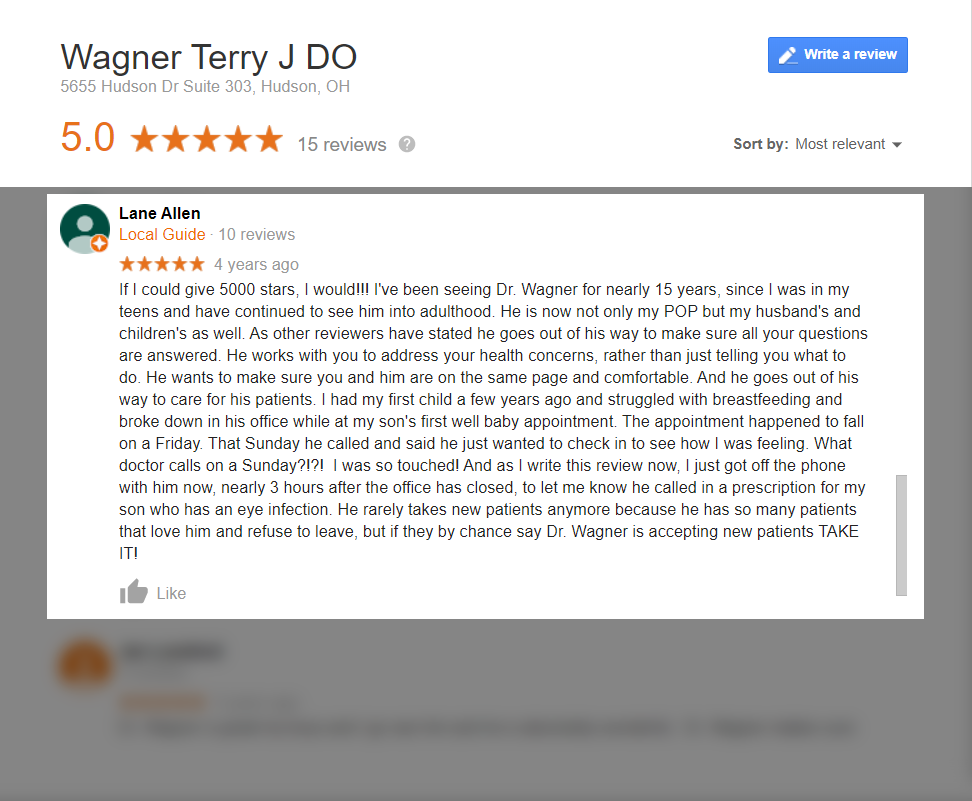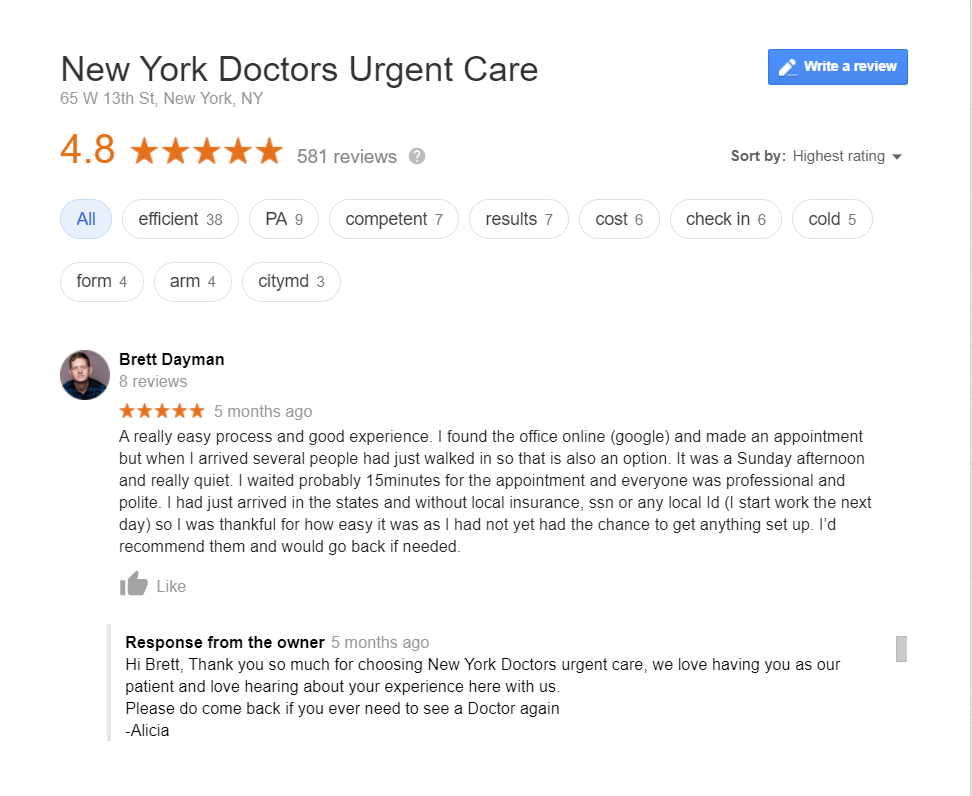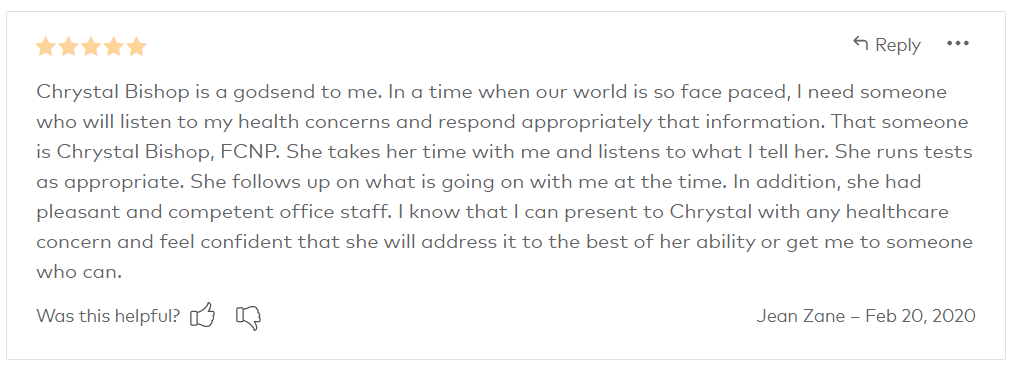Sample Good Reviews for Doctors and Dentists by Patients
So how do you write a good review for a doctor? Let’s go over the step-by-step process and look at a few samples for reference.

Reviewing services, businesses, and products is a giant industry. Professionally, film critics could make over $80,000 giving their opinion on upcoming blockbuster films. But there are also entire communities on Youtube and other video platforms devoted to assessing the latest technologies, cosmetic items, shows, etc.
In fact, over half of all Americans rank product reviews and ratings as the most crucial attribute of their shopping experience.
Although these popular rating websites, channels and communities wouldn’t exist unless people took the time to participate. Those who actually do are in the minority.

This discrepency happens for thousands of reasons including...
- The industry the business is in isn’t reviewable
- The service they received was good but didn’t stand out
- The business doesn’t have many as it is and no wants to “break the ice”
- The target consumers aren’t the type to leave them
- Consumers are busy
The first point in the list above isn’t entirely true because every business is reviewable and most modern ones actively seek them from their most trusted clients. One of those types of businesses is doctors’ offices.
Physicians and practice owners are starting to realize how essential patient testimonials are to their business and how much they reflect the quality of patient care. The only problem is that there’s more involved with reviewing their services than a Mom and Pop general store.
What Are Patient Reviews and Why Are They Important?
Defining Patient Reviews
Patient reviews are written feedback from patients about their healthcare experiences. There are a few different types of reviews patients can leave .
Star Ratings
Star ratings give patients a quick way to summarize their overall experience at a physician’s office. Most platforms use a 5-star system, where 5 stars signals an excellent experience and 1 star indicates a very poor one. These ratings are useful at a glance because they allow future patients to quickly gauge the general reputation of a provider.
Detailed Written Reviews
Detailed written reviews provide context behind the star rating, giving potential patients a clearer picture of what to expect. Instead of just showing how satisfied someone felt, these reviews explain why they gave that rating. This helps others understand specific strengths or weaknesses like rushed visits or billing issues.
Anonymous Reviews
Anonymous reviews can be either positive or negative, but should always be read with caution. Since the reviewer's name isn't attached, people are more comfortable expressing themselves freely, sometimes leading to more honest feedback, but other times resulting in exaggerated complaints.
Anonymity can also be a benefit. Patients who may feel nervous about sharing personal experiences, or who worry about being identified, often find it easier to leave feedback without attaching their name. This allows for a broader range of perspectives that might not otherwise be shared.
Named Reviews
Named reviews are often seen as more credible because the reviewer attaches their identity to their feedback. When a name is included, it signals accountability, patients are less likely to exaggerate or post something misleading when their comments are tied to them. For providers, these reviews feel more authentic and trustworthy, and for future patients, they provide reassurance that the feedback is genuine.
The Impact of Patient Testimonials on Healthcare
Patient testimonials play a powerful role in shaping healthcare decisions. They build trust and credibility, since people naturally trust other patients' experiences more than advertisements. Reviews also influence a doctor’s online reputation, consistent positive feedback can attract patients, while repeated negative comments may raise concerns. Beyond reputation, testimonials carry SEO benefits helping practices rank higher in local search engines and improving visibility. Reviews also support the growing demand for transparency in healthcare, giving patients an honest look at the quality of care they can expect before choosing a provider.
How to Write an Effective Review for a Doctor
Step 1: Select The Right Review Site
If you Google the phrase “review websites” you’ll reach billions of results. Scroll down a little bit from the search bar and you’ll get bombarded with blog posts that list these types of websites. They’re helpful, but they won’t help your endeavor. Most of them list 20 or more websites you can use.

Although you want to take your time, evaluating each of the websites listed within these blogs posts isn’t worth it. It’ll take you longer to look at each one than it would to finish writing your review.
Instead, the best way to determine what site you should use for your doctor is to Google them.
Unless it’s a brand new practice, Googling them will help you determine two things…
- Whether or not they’re patients are active online
- Which websites those patients post their opinions on the most
Let’s look at an example…

The picture above shows the search results for a local doctor near our headquarters, Dr. Laura W. Meyer, DO. For her, you can immediately see that her patients are active across multiple different assessment websites. She’s even set up her Google My Business page, which gives important information on the right-hand side.
Even though she’d likely appreciate a review on any of these websites, the best place to leave one is where her patients are most active.
Choosing the right rating website ensures that what you submit gets viewed. Since you’re putting time in to come up with what you want to say, getting views is an added bonus.
So for this example, the best place to post anything about Dr. Laura W. Meyer would be with the majority.
This gives her patients two options.
First, although she has more than 31 votes on WebMD’s Physician Directory, there aren’t any written reviews. Posting a written one here would get a lot of views but yours would be the only one on that particular site.
Another option for her is on Vitals.com. Her patients are very active there as she has 29 votes and about five written submissions.
Step 2: Interview Yourself
Once you’ve found the perfect place to post your review, it’s time to start the drafting process. This all starts with self-reflection. To make this process easier, imagine someone is sitting across from you, interviewing you about experiences you’ve had with your doctor.
Think about what you’d want to know if you were a new patient. If you’ve ever switched your doctor, you’ll remember how this task can get tedious. However, you’ll also know what factors you looked for during the evaluation stage.
Ask yourself reflective questions like…
- What are the three qualities you like most about this doctor?
- How long have you been going to them?
- How does this doctor make you feel?
- How is their bedside manner?
- How much time do they give me to ask questions?
- Do they answer each question in an understandable way?
- Do they clearly explain symptoms, prescriptions and side-effects?
- Have you ever mentioned to them getting a second opinion? How did they react?
- Does anything about their appointment scheduling process stand out?
- What’s your favorite part of the entire appointment experience?
- How does their staff make you feel appreciated?
- How easy was the payment process?
- How reasonable is the wait time before your appointment?
- How friendly and professional was the staff,especially the receptionist at the front desk who first greeted you?
What you ask yourself isn’t limited to the questions above but record your answers. As you go through them you’ll naturally start to think of new topics to cover in your review.
Step 3: Write The Review
Once you’ve finished step 2, you can use your answers to serve as an outline.
Have you ever looked up a restaurant, navigated to their reviews section and saw a bunch of generic ones? I’m referring to those that state, “Awesome food!!” with a 4-star rating. Although those may benefit the restaurant by serving as a boost if they have a lower rating, they don’t help anyone else. If she’s great, why only give a 4-star rating?
The doctor we mentioned earlier has a similar Google Review to what I’m talking about.

A statistical analysis of 1,489,194 Amazon product reviews published in June of 2015 found that the longer ones were more helpful and persuasive. That’s because it helps paint a picture for the reader. Personal anecdotes give a detailed, first-hand experience that helps readers get an understanding of what it’s like going to the doctor you’re critiquing.
But how long is too long and how much detail is too much?
Length
According to a similar statistical study to the one mentioned earlier, the most helpful reviews are between 1,000 - 2,000 characters in length.

Of course, the graph shows that posts beyond that character range are also considered helpful but keep in mind that 2,000 words around 4 pages in length. That might take a little too much time out of your day to write.
When it comes to length, you’ll want to keep what you write detailed yet concise enough that the reader won’t feel as though you’re rambling. Stay on topic and keep your goal in mind.
Detail
Once you’ve determined how much you’re willing to write, it’s time to begin the drafting process. The good news is, you’ve framed the main topics to cover from the questionnaire outline you filled out in step 2.
Now it’s time to decide what personal anecdotes you want to add and how specific you want to get. Your health and the care you receive is personal information that’s protected by law. Your doctor can’t share that information without your permission. If they did, they’d face a HIPAA violation. But it’s ultimately up to you how personal and detailed you want to get.
Alternatively, if you wanted to err on the side of privacy you could still give a detailed, good evaluation anonymously. Either way, share what you’re comfortable with sharing.
Tone and Writing Style
While you’re writing your submission it’s important to keep in mind your tone of voice, writing style and storytelling.
First, what’s important to understand is that all reviews are somewhat subjective. There’s no real way around that. However, keeping that in mind while you’re writing will make it easier for you to point out anything you say that’s overly subjective. Thus, you’ll be able to steer it towards a more objective tone.
Second, your writing style should reflect your personality. After all, this is a first-hand account of your experiences with your doctor, the entire staff, and other healthcare professionals. If you feel you’ve found the best doctor, explain what made them stand out, whether it was their compassionate approach, excellent care, or respect for your time. That also means that the tense you use should reflect that as well. In other words, write in the first person.
Third, put an emphasis on storytelling. According to Wired.com, “Storytelling is a central to human existence.” That may sound a little over exaggerated but they have a point. Your ability to tell a story is the difference between just an okay assessment and a positive review that people will use as a reference for years to come.
Common Mistakes in Doctor Reviews
When writing doctor reviews there are mistakes people make, lets look the most common mistakes:
Being too vague:
A simple “Great doctor!” or “Terrible experience” does not give future patients enough information to make a decision. While short comments show whether the experience was positive or negative, they don’t explain why. Without specifics, readers can’t tell if the doctor is skilled at listening, if the office runs efficiently, or if the bedside manner is strong.
Overly emotional:
It’s natural to feel strongly about a medical experience, but reviews that are overly emotional can come across as biased. Phrases like “The worst doctor ever!” don’t provide any insight into what actually went wrong.
Making the review too short or too long:
Reviews that are just a sentence or two are not very helpful, but extremely long ones may lose readers attention. The ideal length is typically 1,000-2,000 characters (about 150-300 words). This is enough space to share meaningful details without overwhelming readers.
Samples of Good Reviews for Doctors and Dentists
Even though you now know how to write a good review for a doctor, you might still want to look at some samples for reference. We’ll also break down why they’re great.
Sample 1: Terry Wagner DO

The first doctor sample we have for you comes from a local physician near our headquarters. There are a few big takeaways from this example.
First, it’s a Google Review from some who acquired the “Local Guide” title. Local Guides have precedent over other users because they’re enrolled in Google’s reward program for posting their thoughts.
Essentially, as they leave more helpful critiques on Google Reviews, they’ll receive tiered rewards. Receiving a submission from a Local Guide is great because they’re viewed as more trustworthy and usually go more in-depth.
Second, the content itself is very well written. You can immediately tell that the user spent time reflecting on their experience with this doctor. The result is a well-thought-out review discussing how this physician cares about his patients, even outside office hours.
Sample 2: New York Doctors Urgent Care

Our next example is unique, not only because of its format but also because the healthcare organization responded.
The evaluation itself is short and concise. It’s also written in a way that’s friendly to the reader. The user summarized his experience within the first few words while providing more detail within the subsequent sentences.
The healthcare organization sent a personalized response that’s also signed by one of their employees. This not only acknowledges the time and effort the user put into their review, but it also adds a human element to an otherwise digitized space.
Sample 3: New York Doctors Urgent Care

Our third sample is good because it’s light-hearted while providing additional content beyond what’s written.
The user references the fact that he chose a treatment titled “Limitless Drip” based off of the 2011 movie. He then states that he “felt much like Bradley Cooper did in the movie.” It’s a lighthearted take that’s effective. He also attached pictures to his review which helps others know what the place looks like prior to their visit.
Sample 4: Chrystal Bishop, FNP-C

Our fourth sample comes from a different website for doctors called healthgrades.com.
It’s similar to the other samples provided within the blog post but we felt it was necessary to show you what a good submission looks like on a different website just in case your physician is more active on something outside of Google Reviews.
Conclusion
You have a lot of power both as a consumer in the commercial space and as a patient within healthcare. As the medical industry moves towards transparency, your opinions are becoming even more impactful. Writing a thoughtful, detailed review for a doctor that you often visit is a task to take seriously and, once its complete, it’ll help in two main ways. First, it’ll increase the physician’s patient volume. Second, it’ll make the decision process easier for patients looking for new healthcare professionals and services by highlighting the excellent care provided by the entire staff, helping to build trust and strengthen the providers online reputation.
Every review you write adds to a larger culture of trust and accountability in healthcare. Even a few sentences can guide someone toward the right provider, encourage transparency, and recognize the dedication of medical professionals. By sharing your experiences, you’re not only supporting your physician but also helping future patients feel more confident about their healthcare choices.
Emphasize your product's unique features or benefits to differentiate it from competitors
In nec dictum adipiscing pharetra enim etiam scelerisque dolor purus ipsum egestas cursus vulputate arcu egestas ut eu sed mollis consectetur mattis pharetra curabitur et maecenas in mattis fames consectetur ipsum quis risus mauris aliquam ornare nisl purus at ipsum nulla accumsan consectetur vestibulum suspendisse aliquam condimentum scelerisque lacinia pellentesque vestibulum condimentum turpis ligula pharetra dictum sapien facilisis sapien at sagittis et cursus congue.
- Pharetra curabitur et maecenas in mattis fames consectetur ipsum quis risus.
- Justo urna nisi auctor consequat consectetur dolor lectus blandit.
- Eget egestas volutpat lacinia vestibulum vitae mattis hendrerit.
- Ornare elit odio tellus orci bibendum dictum id sem congue enim amet diam.
Incorporate statistics or specific numbers to highlight the effectiveness or popularity of your offering
Convallis pellentesque ullamcorper sapien sed tristique fermentum proin amet quam tincidunt feugiat vitae neque quisque odio ut pellentesque ac mauris eget lectus. Pretium arcu turpis lacus sapien sit at eu sapien duis magna nunc nibh nam non ut nibh ultrices ultrices elementum egestas enim nisl sed cursus pellentesque sit dignissim enim euismod sit et convallis sed pelis viverra quam at nisl sit pharetra enim nisl nec vestibulum posuere in volutpat sed blandit neque risus.

Use time-sensitive language to encourage immediate action, such as "Limited Time Offer
Feugiat vitae neque quisque odio ut pellentesque ac mauris eget lectus. Pretium arcu turpis lacus sapien sit at eu sapien duis magna nunc nibh nam non ut nibh ultrices ultrices elementum egestas enim nisl sed cursus pellentesque sit dignissim enim euismod sit et convallis sed pelis viverra quam at nisl sit pharetra enim nisl nec vestibulum posuere in volutpat sed blandit neque risus.
- Pharetra curabitur et maecenas in mattis fames consectetur ipsum quis risus.
- Justo urna nisi auctor consequat consectetur dolor lectus blandit.
- Eget egestas volutpat lacinia vestibulum vitae mattis hendrerit.
- Ornare elit odio tellus orci bibendum dictum id sem congue enim amet diam.
Address customer pain points directly by showing how your product solves their problems
Feugiat vitae neque quisque odio ut pellentesque ac mauris eget lectus. Pretium arcu turpis lacus sapien sit at eu sapien duis magna nunc nibh nam non ut nibh ultrices ultrices elementum egestas enim nisl sed cursus pellentesque sit dignissim enim euismod sit et convallis sed pelis viverra quam at nisl sit pharetra enim nisl nec vestibulum posuere in volutpat sed blandit neque risus.
Vel etiam vel amet aenean eget in habitasse nunc duis tellus sem turpis risus aliquam ac volutpat tellus eu faucibus ullamcorper.
Tailor titles to your ideal customer segment using phrases like "Designed for Busy Professionals
Sed pretium id nibh id sit felis vitae volutpat volutpat adipiscing at sodales neque lectus mi phasellus commodo at elit suspendisse ornare faucibus lectus purus viverra in nec aliquet commodo et sed sed nisi tempor mi pellentesque arcu viverra pretium duis enim vulputate dignissim etiam ultrices vitae neque urna proin nibh diam turpis augue lacus.




